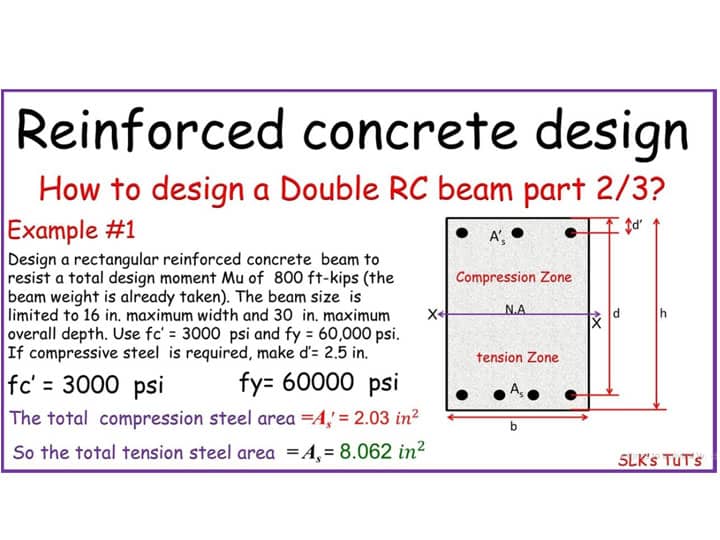A beam is a structural member holding up vertical loads. It is also the part that prevents the structure from bending. Beams made of concrete are generally of two types, singly-reinforced, and doubly-reinforced. Today, we present a three part video lecture on doubly reinforced concrete beam.
A doubly reinforced beam has two kinds of reinforcement, as the name implies. It can resist both compression and tension forces, due to the two respective kinds of reinforcements. These steel reinforcements are generally on both the top and bottom sides of the beam.
Generally, when the depth of the beam is restricted, the doubly reinforced beams are used to provide extra support in the limited space. The bending moment can be increased in this manner. However, please note that the resistance moment of the beam cannot be increased more than 25% in this manner.
The neutral axis of the beam divides it into two zones ? the compression zone and the tension zone. Steel bars are placed in both zones to provide resistance to the respective forces acting in those zones. The first type of reinforcement is called the compressive steel and the second is called tensile steel. When you use only tensile steel, the beam becomes singly reinforced RC beam and is not under the scope of this article. Those beams are okay when there are lots of space to provide a lot of concrete to generate the compressive strength.
But what if there isn't enough space for the beam? In that case, the cross section of the beam is limited in height, and so you just don't have enough room to put the concrete. In that case the compression force acts at the bottom of the beam, which can break it. For this reason, you have to put an extra reinforcement bar at the bottom of the beam, in the compressive zone, too. Then it becomes a doubly reinforced beam.
This beam, as a result, can resist both compressive and tensile forces. However, note that in this type of continuous beam, there will exist both positive and negative moments (positive on top and negative on the bottom of the beam). The tensile steel handles the positive moment and the compressive steel will handle the negative moment.
Today, we will share a three part lecture on how to design a doubly reinforced RCC beam. The videos are posted in Engineer Boy's youtube channel. The first video covers the basics of the double RC beam, it's advantages, etc. The second part presents a particular scenario of designing a doubly reinforced beam (total design moment: 800 ft-kips, beam size is limited to 16" x 30" max, fc' = 3000 psi and fy = 60,000 psi, d'= 2.5") - and goes on to solve it. The third part will test the solution with the ACI code requirements.
Thanks for watching, and reading the article. Please let us know your thoughts and suggestions in the comment box below.
